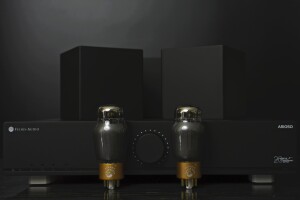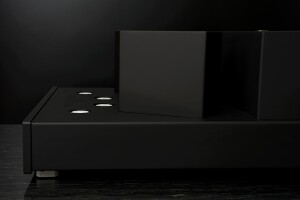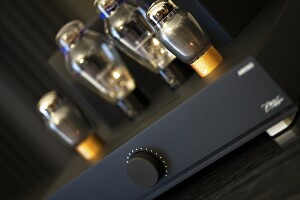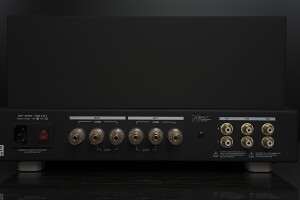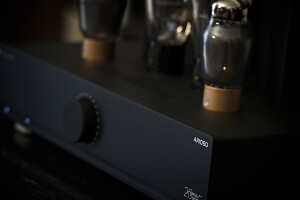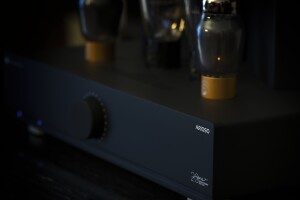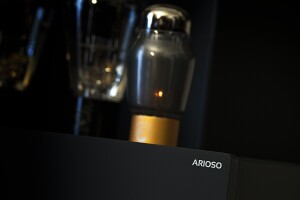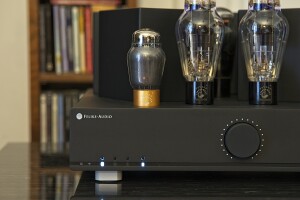Feliks-Audio is one of these Polish manufacturers that are probably better known abroad than in our country. The core of their lineup are headphone amplifiers, but for my first encounter of the third kind I chose a classic integrated amplifier, one released to celebrate brand’s 20th anniversary, the Feliks-Audio Arioso 300B SET.
Introduction
Over the past several years, I have written at least a couple of hundreds reviews of Polish audio products and I’ve always tried to encourage readers of various magazines not to go and buy them, but to simply give them a chance. As a nation, we have nothing to be ashamed of. Our domestic brands offer products that not only sound good, but are competitive in terms of workmanship and finish quality. Many of the components I reviewed were as competitive as it gets compared to foreign counterparts and more than once they came out on top. Yet, even though I have always been a vocal supporter of Polish manufacturers, I have somehow never reviewed any product of the Feliks-Audio. I have no explanation for the obvious question – why? It’s even more surprising considering the fact that this company is based in Lubliniec, a city located not far from my hometown Gliwice, and it specializes in designing and production of tube amplifiers, so my personal favorites.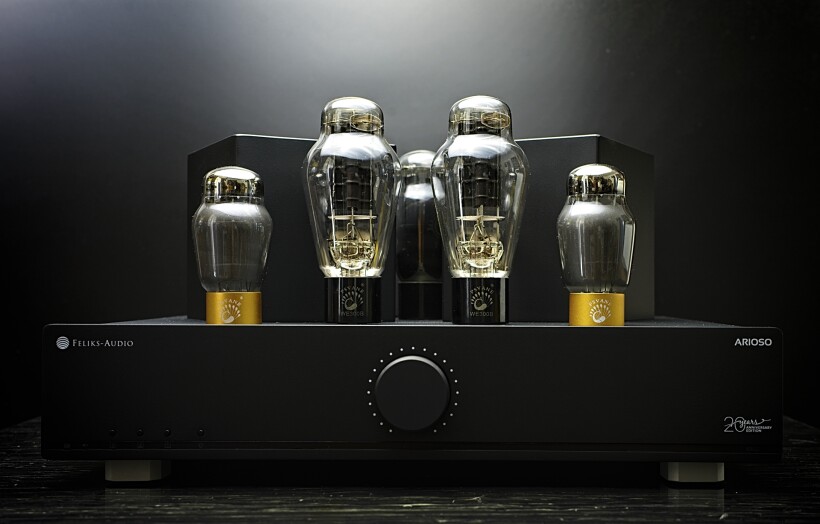
The lineup is dominated by headphone amplifiers, but there are also some interesting proposals for those, who prefer to listen to the music using loudspeakers – me included (not that I have anything against headphones – it’s just a matter of personal preference). Mistakes are an integral and useful part of life, provided, of course, that one learns from them. So I decided to repair one of my own mistakes and get to know at least some devices from Lubliniec starting with the Arioso 300B integrated amplifier. I should mention though, that there are already next two reviews planned, including one of a headphone amplifier, and after already listening to the Arioso 300B for some time I am looking forward to them.
Polish distributor (from my hometown of Gliwice), the 4HiFi, for the first test delivered a model that was officially presented end of last year as a part of celebration of brand’s 20th anniversary. You may have already learned a little more about the company’s history in an interview with Mr. Łukasz Feliks, see HERE (if you haven’t read it, please do!). So let me only remind you, that the Feliks-Audio was founded by the senior of the family, Mr. Henryk Feliks, an electronic engineer, which, as you’ve probably already noticed, explains the origin of the brand’s name. Before the Arioso 300B there had been already another model called Arioso featuring another legendary triode, the 2A3. As Mr Łukasz Feliks, one of the three sons of Mr Henryk involved in running the family business, explained, at some point they made several units of this amplifier with 300B tubes, simply because of the appreciation of this triode’s unique sound signature highly appreciated by the brand’s designers. As these received positive feedback also from customers, who had a chance to listen to them, company decided to officially introduce the 300B version as one of the anniversary products. A bit later, Felix-Audio decided to keep it in the lineup for good and at the same time render the original one with 2A3 triodes obsolete. The unit I got for this review was still labeled “20 Years Anniversary Edition”, but the ones currently offered will be simply called: Arioso 300B.
Design & Features
The Arioso 300B is a tube integrated amplifier, and its Single Ended output stage features, as the name suggests, the magical 300B triodes (one per channel, obviously). It combines some features of a classic SET design with some non-standard solutions. The chassis is made of metal sheets with a thick aluminum front. The whole features a nice black mat finish which is combined with some contrasting white elements including four anti-vibration feet. Centrally on the front there is a black, medium-sized volume knob, and the scale is marked with white dots around its perimeter. I think an addition of another white dot or a small LED on the knob, which would make it possible to identify volume level from a listening position, would be appreciated by many users. In three corners of the front panel there are small white inscriptions – the company’s logo, model name and, in the case of the reviewed unit also an additional “20 Years Anniversary Edition” designation.
At first glance, it seems that the knob is the only manipulator, which considering the fact it’s an integrated amplifier would be a very unusual solution. However, near the lower edge of the front panel, on the left side, there are four tiny, black, and therefore almost invisible push-buttons. Below, there are also illuminated micro-markings explaining their functions, plus a fifth one that indicates activation of the “mute” function. One of the aforementioned buttons turns the amplifier on and off, the other three allow user to select one of the three line inputs (RCA). The input selection, volume control, on/off and mute functions can also be operated via the remote control. The latter, by mistake, did not arrive to me with the amplifier so I couldn’t test its operation. I didn’t press for rectifying this mistake simple because, as an owner of a SET 300B, the modified Art Audio Symphony II, that does not feature remote control at all, I am used to manual operation of this type of amplifiers.
The chassis is rectangular in shape, but it is the depth that is the greater dimension – it’s one of the features that differentiates this design from most. It measures (D x W x H) 410 x 330 x 210 mm (with tubes), weighing 18 kg. So it is neither as large nor as heavy a device as many other SET amplifiers. Does it matter? It often does, as the size of power and output transformers, more often than not, matter, but as one of the best 300B SETs I reviewed, the AirTight ATM 300R, proved to me clearly, moderate size and weight do not have to exclude a remarkable performance. This shape of the Arioso 300B probably results, at least in part, from the unusual arrangement of the elements on the top surface of the amplifier (unless the arrangement results from the adopted shape…). At the front, there are two driver tubes. These are the excellent PSVANE CV181-T II (the so-called “golden” PSVANE 6SN7). Placed slightly behind them and closer to the middle of the chassis, there is a pair of 300B power tubes. The default model is the Electro-Harmonix Gold, but I also got a second pair of these triodes from the 4HiFi for testing – the Western Electric 300B replicas, also produced by PSVANE. So far, in terms of the arrangement of elements, the Arioso 300B seems to follow standards.
It’s just that behind the power tubes there are two transformer housings and they are not placed parallel (or perpendicular – a matter of the point of view, especially as they are square) to the front / rear edge of the device, but they are set at some angle (probably 30 degrees or so). The optical effect is very interesting, the more so that behind them, but still visible through the gap between, and at the same time in front of a larger housing with output transformers, there is a rectifier’s socket and the tube itself, the 5C3S (NOS). It is a matter of taste, but I liked the whole layout a lot and its simple, but eye-catching elegance. By default the amplifiers are not equipped with a tube grid/cover, but it is an optional element one can order with one’s unit.
On the rather standard rear panel, one finds a set of the aforementioned three unbalanced line inputs with gold-plated RCA sockets and speaker outputs, separate for 8 and 4-ohm loudspeakers, accepting bananas, spades and bare wires. There is also an IEC type power inlet with a mechanical, illuminated main switch. To be honest, I didn’t take a peek inside – as usual in the case of tube amplifiers, disassembling is not an easy task. Therefore, using the information provided by Mr. Łukasz in the interview, let me just mention that the circuit was assembled using the “point-to-point” technique. It features selected, high-class components, such as: motorized blue ALPS potentiometer (that allows remote control), hi-end class transformers manufactured by highly respected manufacturer, Mr. Ogonowski, “red Jantzen” coupling capacitors, and Caddock and Carbon Film resistors. The output tubes (300B) use stabilized DC current heater supply and the manufacturer used a special system that separates the tube heating circuit from the stabilizing one. The amplifier, like most 300B SETs, is capable of delivering up to 8W per channel.
Sound
Let me open this part of the review by saying that when I started listening to the Arioso 300B, I almost immediately thought that it would be a perfect tool to, when combined with a good source and appropriate speakers (such as, respectively, my DAC – LampizatOr Pacific on a digital front and J.Sikora Standard Max turntable on analogue’s, and MACH4 loudspeakers) to clearly present the case of how yielding to stereotypes in audio make no sense. What does is the stereotype regarding 300B SET’s performance, at least according to many people with whom I had an opportunity to talk about it? Well, it says that such amplifiers deliver a warm, not particularly fast sound, with an emphasized, colored midrange and rolled off frequency range extremes. Some people appreciate also a few positives – spacious, palpable and highly expressive performance. This is what many people think of SETs’ sound. Where does it come from? Either from brief auditions of some not particularly good models (yes, such models also do exist), or, which is much more common, from pairing them with unsuitable loudspeakers.
This is the most common mistake, which doesn’t allow low-power Single Ended amplifiers to present their great capabilities (I’m not saying that they are versatile devices, but in what they do, they are absolutely fantastic, if given a chance). In fact, such an opinion has little to do with an even decent representative of this specific amplifier genre, provided that, once again, it is fed with a high-class signal and drives appropriate loudspeakers. Such as, for example, the GrandiNote MACH4 that I am using currently, or my previous ones – the Bastanis Matterhorns. The thing is not only in the (relatively) high efficiency of said speakers, but also a friendly, flat impedance curve. I would even say that the latter is actually the key factor in achieving success when using a low-power tube amplifier.
Many loudspeakers of medium (in some cases even low) efficiency and with a flat impedance curve have a much better chance of performing really well driven by a SET than even those with higher efficiency, but with significant impedance drops. One of such fantastic combinations I experienced first hand, were the iconic LS 3/5A by Falcon Acoustics (the most faithful copies of the legendary BBC monitors currently manufactured), i.e. loudspeakers with an efficiency as low as 83 dB, but with an impedance of 15Ω (quite flat). These cute little „shoe boxes” driven with my 8W 300B SET presented absolutely amazing musical spectacles, although it is not to say that such setup was perfect for all kinds of music. I keep mentioning the importance of selecting the right loudspeakers for any tube amplifier in each review of such device, which may be boring for some Readers, but I think it is worth it, because it is an absolutely key factor in any SET-based system. It will also be a key to success if one wants to use the Feliks-Audio Arioso 300B if it is to present its full potential. Anticipating conclusions of this review, let me already say, that if you ley it, the Arioso 300B will amaze with its GREAT POTENTIAL. So make sure you pair it with appropriate (not only on paper, but in real life) speakers!
Back to my thought regarding stereotypes. The Arioso 300B, listened to, at first, with the standard Electro-Harmonix tubes (300B Gold), as soon as it warmed up a bit, because like any tube amplifier it needs several minutes for it to happen and to fully „spread its wings”, firmly and to a large extent (not fully, as it agreed with the aforementioned positives) denied that stereotype. Does it sound warm? Sure, but it’s a natural warmth – if you have ever listened to live (acoustic) instruments you know that they sound warm, never cold, in nature! A unique, resolving, rich, smooth, refined and tangible midrange? Absolutely, but it’s not pushed forward, there is no coloration or artificial domination in relation to the band’s extremes! Already with the Electro-Harmonics tubes the sound is reach, although there is no that unique density, even „creaminess” of the presentation, that the best 300B triodes offer, such as products of the Western Electric or Japanese Takatsuki (and a few other great ones available currently on the market including the PSVANE’s valves, as you’re about to learn).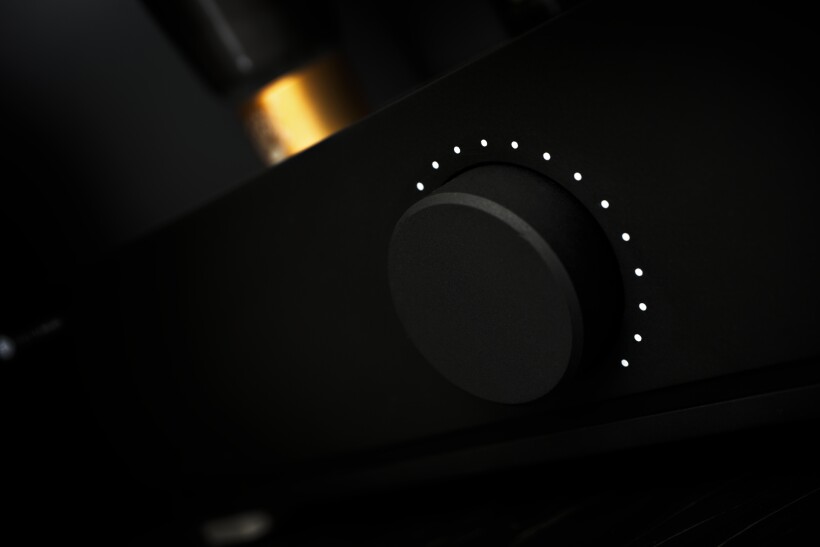
With the Arioso 300B, already with the Russian tubes, the mid and high tones are clean, more transparent and vivid but without any traces of brightening, harshness or aggressiveness. Music is presented in an orderly, coherent, fluid way, as this is how it should sound like with any good 300B-based design. The coherence also concerns the perfect „stitching” of the midrange, which is an essential part of the band in almost every music genre, with both, treble and bass. And while there are some designs that offer even better extended range extremes, it’s really hard to call what the Arioso 300B has to offer in this regard withdrawn or rolled-off. What we get with it is a fast, tight, rhythmic bass and an open, resonant, full of air, even if not quite as delicate, treble as I am used to (with my SET). The latter difference was not a big one and, as I found out bit later, it was a feature introduced by the power tubes. The Russian ones are a bit more “raw”, a bit “harder” sounding than the more refined (also much more expensive) representatives of the 300B family. So how good was the Arioso 300B’s performance? Let me put it this way – I started smiling when listening to the first album with this amplifier and I enjoyed every minute I spent with it. So yes, it was clear from the very beginning that it was a damn good amplifier!
After listening to it for a while I realized that probably many people in a blind listening test wouldn’t be able to tell that Arioso is a 300B SET. Even some fans of this magic triode could have troubles recognizing it. For me it sounded a lot like another fantastic triode, the 2A3, featured in my personal “to die for” amplifier, the crème de la crème (in my opinion, of course) of tube technology, the one and only Kondo Souga. I’m not saying the Arioso is as good as the Japanese masterpiece, but that the general sonic character was somewhat similar. I couldn’t help but wonder if this had something to do with the fact that the Arioso was originally a 2A3 design, later converted into a 300B one (obviously it was a much more complex process than just replacing output tubes)? Anyway, even I, a SET aficionado who had a chance to listened to many, also much more expensive, wonderful 300B amplifiers, was amazed with what the Feliks-Audio designers had managed to achieve with these tubes, offering users an exceptionally expressive, engaging, very live-like musical experience. And at a price that is really attractive for this type of design made in Europe.
Let me point out that, in my experience, signal and rectifier tubes play a big role, maybe even a bigger one in such amplifiers, than output tubes in achieving top performance. By replacing them, which usually also costs less, you can get a clearly better sound. Notice, that the Arioso 300B features premium-class signal and rectifier tubes from the get go. I would go as far as to say, that this is why it was not necessary to use the best, and therefore the more expensive, power tubes to achieve remarkable sonic results. Which does not change the fact that replacing the output tubes with those supplied by the distributor, the 4HiFi, the replicas of the legendary Western Electrics developed by Psvane, introduced a noticeable, or even significant, further improvement to the sound. It wasn’t a mind-blowing difference, but definitely positive and big enough to quickly realize that after tasting the Psvane’s 300B flavor there was no way back to the Electro-Harmonix tubes.
With the introduction of the WE replicas the expected remarkable refinement and „nobility” of the sound appeared, which, in my opinion, can only be achieved using the „royal” triodes, such as 300B, 2A3, 45 (although the latter is slightly less versatile choice), and to a slightly lesser extent (making up for it with other advantages) 211 or PX25. The Arioso 300B with Chinese tubes also offered a noticeably better resolution and vividness of the presentation. In the treble range, which can sound absolutely fabulous with the 300B, the WE tubes replicas finally delivered that bit of sweetness and delicacy I craved for. It is not about sweetening the high tones, because they were still remarkably pure, vibrant and fast, but about even higher culture and naturalness of the sound of (particularly acoustic) instruments, even better differentiation and more convincing, longer reverbs. After fully realizing all these supposedly not so significant individually, but combined rather impressive improvements to the sound, I simply couldn’t go back to the EH tubes any more and the Psvane stayed in the Arioso for the remaining (de facto) larger part of the test. It does not change the fact that even with the former the amplifier stood out from the competition (not only of its price range) offering a truly classy, refined performance. Potential buyers of this device should be simply aware that if they decide one day to replace power tubes with other, higher-class ones, it will further enhance Arioso 300B’s performance. It is up to them if and if so when, they use this option, and they should know that the Psvane’s WE replicas will be an excellent, though not the only possible, choice.
Let me now digress a bit (though I will not go completely off the topic of this review). One day, for the first time since mid-March, I found myself home alone for a few hours. Sort of reacting to the several-months-long restrictions related to the pandemic, I decided to „go a bit crazy”. I prepared a playlist in Roon including tracks by AC/DC, Guns’n’Roses, Aerosmith, ZZ Top, Prince and others, just hit after hit, and turned up the volume on my Shinai (A-Class 2x30W solid-state amp). I will save you a description of my music-related activities, but I should mention that at some point I paused playback in Roon, turned off the Shinai, switched the system to Arioso 300B, pressed play and … went to the kitchen to prepare a meal. I came back half an hour or so later, sat down paying no attention to the sound coming from my speakers. I reached for my laptop and started to continue writing another review, with the music intended only as a background.
After a few minutes, I realized my feet were vigorously tapping a beat. I walked over to the amplifier to turn up the volume a little, then went back to typing. And my feet to tapping the rhythm. After a while my head started rocking (dangerously) too. Meanwhile, Roon turned on its “radio” when the playlist finished. And the „radio” mode it selects tracks based on those from the last playlist. So it kept going with likes of Aerosmith, Guns’n’Roses, AC/DC, Bon Jovi, Rush, and so on, and the Arioso 300B just kept doing a surprisingly impressive job playing this type of music. It did just sent me a signal: “turn the volume up a bit more”, which I did. And for the next few hours rock and hard rock songs, even ones edging on heavy metal, kept blasting from my speakers as if they were driven by a much more powerful amp, not just by the 2 x 8W output, that the 300B SET was able to provide (of course, it did not get even close to its maximum output – it didn’t have to). It was a dynamic, highly energetic presentation with surprisingly good PRAT. And while listening to such music while driving may be dangerous, as one tends to drive faster, writing that review accompanied by the performance delivered by the Feliks-Audio Arioso 300B turned out to be really easy and… pleasant.
This little experiment also proved what not everyone is really aware of. Regardless of how powerful amplifier you have at your disposal, apart from exceptional situations (when you use loudspeakers that are extremely difficult to drive, or when you want to demolish walls with sound, bully your neighbors, or fill a huge room with sound), you actually use only a fraction of the output capabilities of a given device. Often, only the first few watts are all you need (hence one of the well-known theories saying that what really matters, when it comes to amplifiers, is the quality of the first few watts, or even the first one – the name Nelson Pass should be familiar to most of you, isn’t it?). And yes, the so-called headroom is important, because an amplifier operating at the limit of its capabilities starts to have problems with significant clipping/distortions. The thing is, that even an 8W amplifier, such as the Arioso 300B, with a robust power supply and output transformers, driving suitable loudspeakers in a not too big room, will allow you to go crazy even with heavier types of music, because all you really need is a few watts. And since the midrange plays a huge role in rock as well, and the 300B is the master of it, you may expect a treat, a truly unique experience. Maybe without a tectonic bass, without your liver getting a free massage, which you may be used to if you’re using some powerful solid-state amps, but instead you’ll appreciate a fantastic density and fluidity of the sound, high dynamics and energy and sort of an enthusiasm that will not allow you to stay indifferent to the musical spectacle taking place in front of you. It is just going to pull you in and keep you involved. End of digression. If you consider it a digression.
From what I’ve described above one can already conclude that the Feliks-Audio Arioso 300B is an amplifier that, let me repeat it once more – when combined with appropriate loudspeakers, is suitable for (almost) any music, including the heavier genres. The difference, compared to powerful competitors, being not its raw power that makes it possible, but rather a proper pace and rhythm delivery, nicely extended, tuneful bass that even at the very bottom is dense, nicely differentiated, has a proper weight. It is still not all the Arioso 300B has to offer – with the MACH 4 bass was also surprisingly tight and fast (admittedly, not quite on par with powerful solid-states), and there was nothing to complain about regarding control, definition and differentiation. In fact, even to my surprise, the reviewed SET presented it with energy and enthusiasm (almost) worthy of a classic American solid-state.
At the same time, Arioso 300B made sure that the bass notes delighted with richness, beautifully conveyed timbre and texture, even low-level resolution which at such a level one expects from much more expensive components. Below you will find a description of my system, but just in case let me emphasize, that the Arioso 300B was surrounded with (much) more expensive components. Only cables and the cartridge (although the latter by not much) were cheaper than the reviewed SET in this setup. Loudspeakers, turntable, DACs (my Pacific and the tested Weiss DAC501) cost several times more. In theory, therefore, the Polish 300B integrated should have been a bottleneck of this system. Maybe it was. It’s just that I couldn’t really hear that, not really. It did a fantastic job, so good that I wasn’t in rush to go back to the more expensive amplifiers that I had at hand.
I realize, that bass range is not the only one that matters, although its quality exceeded my expectations by so much that my listening sessions, hence the review, revolved around it. Probably the first time ever I wrote something like this in the review of an 8-watt tube amplifier … although it could have happened once before, when describing a competitor from the AirTight lineup (that is about 4 times more expensive). It does not change the fact that hardly anyone buys a 300B SET for its bass performance. What most are looking for in any SET is the pure magic of its midrange presentation, stunning holography, fabulous, live-like vocals and acoustic instruments performances and exceptional, pure, vibrant, yet delicate treble. And the Feliks-Audio Arioso 300B delivered it all in spades. It seemed that it achieved it effortlessly delivering performance that definitely surpasses expectations one may have for a 15 kPLN amplifier.
It should be obvious, but still, let me make it clear – this type of an amplifier is a proposition primarily intended for those who love acoustic music (including classics!) and vocals (including my beloved operas). It is in this type of recordings that the naturalness and tangibility of the presentation reach such a level that all one has to do is to close one’s your eyes to experience something very unique, something very close to what live performances have to offer. Especially since the tone, texture and the so-called “presence” of each instrument and voice is stunningly realistic and convincing. The high resolution and abundance of details delivered by the Arioso 300B do not overwhelm listeners at all, because they are used not to wow them but as basic components to build a larger, complex, fabulously tuneful, immersive, often, simply put, breathtaking musical spectacles. And that’s exactly why we love SET amplifiers for. This experience reaches an even higher level when you feed the reviewed amplifier with good live recordings. The Arioso 300B has this, rare in audio, but almost inherent feature when it comes to SET designs, i.e. the ability to convey the high energy of live music. The thing is, again, not in a raw power of the sound, but in this capturing, lively energy of each, even a gentle pluck of a string, a drum or cymbal hit, the quietest note of a piano, which characterizes live performances and which is usually lost in part in the recording and replay process.
On top of that, whenever a sound engineer managed to capture the chemistry between the performers, as well as the interactions between them and the audience, during a concert on a tape (or in a file), the Polish SET is capable of taking full advantage of it and quickly includes listeners in concert’s atmosphere, turns them into participants, as opposed to just recording’s listeners. The more so that everything that happens on the stage and among the audience is complemented by realistically rendered room acoustics, ambiance and full, long reverbs. Everything takes place in a three-dimensional space completely filled with air, in which the real-size, palpable performers seem to materialize in front of the audience. There is no way to resist it, you just have to let the music take you over. The Arioso 300B, a high-class 300B SET offers a unique, absolutely wonderful experience! What more could you expect from it?
Summary
A SET based on the famous 300B tubes for around 15,000 zlotys usually means a good, although quite as often only an average (in terms of sound/workmanship/finish quality) design, which can be hardly counted among proper representatives of this type of design. Yet, the Feliks-Audio Arioso 300B is a “living” proof that, first of all, Polish brands do offer remarkable products, and secondly, that for a (relatively) reasonable amount money, they are able to offer an excellent amplifier, capable of competing with much more expensive models from abroad. The Arioso 300B, in my opinion obviously, is a SET that you could spend your whole music-lover life with, without ever looking back. The Polish amplifier catches the eye with its elegant simplicity from the outside, but also wins the ears and hearts of a true music lover not just with a true SET magic, but with one exceptionally well delivered and complete. To put it as simply as possible, the Feliks-Audio Arioso 300B, despite its moderate price, is able to turn listening to the music into a unique, immersive experience. You can spend long hours with it without ever a hint of fatigue, with a smile on your face, listening to an album after album, never really thinking about the sound as such, but rather enjoying experiencing the MUSIC. And you’ll never get enough of it. That’s what SETs are for! Give it a chance (with appropriate speakers !!!) – you won’t regret it!
Specifications (according to the manufacturer):
- Output: 2 x 8W
- Frequency range: 15Hz – 32KHz +/- 3dB
- Input sensitivity: 1V RMS
- Input impedance: 100KOhm
- THD: 0,3% @ 1KHz @ 1W and 2,5% @ 1KHz @ 8W
- Loudspeaker outputs: 4 and 8 Ohm
- Input selector: 3 RCA inputs selected using push-buttons on the front panel or via remote control
- Complete remote control: ON-OFF, input selector, volume, mute
- AC: 230V, 50Hz; optionally 115V, 60Hz
- Power consumption: 140VA/
- Dimensions: 410x 330 x 210mm (incl. tubes)
- Weight: 18kg
- Tube complement: CV 181 TII drivers , 300B power tubes, 5C3S rectifier
Price (when reviewed):
- Feliks-Audio Arioso 300B: approximately 4.500 EUR
Manufacturer: FELIKS-AUDIO
Associated equipment:
- Analogue front end: J.Sikora Standard MAX turntable, J.Sikora KV12 tonearm, AirTight PC-3, phonostages: Grandinote Celio mk IV, ESE Lab Nibiru V 5.
- Digital source: a passive, custom PC with WIN10, Roon, Fidelizer Pro 7.10, JCat USB Femto card with iFi power supply, Hdplex linear power supply for PC, JCAT USB Isolator
- D/A Converter: LampizatOr Pacific +Ideon Audio 3R Master Time (USB signal regenerator), Weiss DAC501
- Power amplifier: Art Audio Symphony II (modified), GrandiNote Shinai, LampizatOr Metamorphosis
- Preamplifier: Audia Flight FLS1
- Loudspeakers: GrandiNote MACH4, Ubiq Audio Model ONE Duelund Edition.
- Interconnects: Hijiri Million, Less Loss Anchorwave, TelluriumQ Ultra Black, KBL Sound Zodiac XLR, TelluriumQ Silver Diamond USB
- Speaker cables: LessLoss Anchorwave
- Power cables: LessLoss DFPC Signature, Gigawatt LC-3
- Power: Gigawatt PF-2 MK2 and Gigawatt PC-3 SE Evo+; a custom power line with Gigawatt LC-Y in-wall cable; Gigawatt G-044 Schuko and Furutech FT-SWS-D (R)
- Racks: Base VI, Rogoz Audio 3RP3/BBS
- Anti-vibration accessories: ROGOZ-AUDIO SMO40 and CPPB16 platforms and ROGOZ AUDIO BW40MKII feet, Franc Accessories Ceramic Disc Slim Feet and Wood Block Platform



